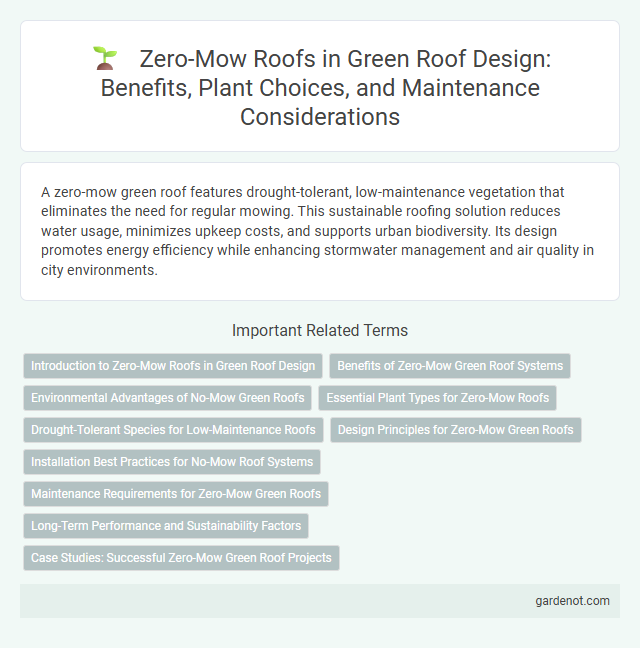A zero-mow green roof features drought-tolerant, low-maintenance vegetation that eliminates the need for regular mowing. This sustainable roofing solution reduces water usage, minimizes upkeep costs, and supports urban biodiversity. Its design promotes energy efficiency while enhancing stormwater management and air quality in city environments.
Introduction to Zero-Mow Roofs in Green Roof Design
Zero-mow roofs feature low-growing, drought-resistant vegetation that eliminates the need for regular mowing, significantly reducing maintenance costs and water consumption. These roofs enhance urban biodiversity by providing habitats for pollinators and improving stormwater management through increased water retention. Integrating zero-mow roofs in green roof design supports sustainable building practices while promoting energy efficiency and reducing the urban heat island effect.
Benefits of Zero-Mow Green Roof Systems
Zero-mow green roof systems significantly reduce maintenance costs by eliminating the need for regular mowing, saving time and labor expenses. These roofs enhance urban biodiversity by providing habitats for pollinators and native plants, improving local ecosystem health. Furthermore, zero-mow roofs contribute to better stormwater management by retaining more rainwater and reducing runoff, which helps prevent urban flooding.
Environmental Advantages of No-Mow Green Roofs
Zero-mow green roofs significantly enhance urban biodiversity by providing continuous habitat for pollinators and native plant species, reducing chemical runoff from fertilizers and pesticides. These low-maintenance roofs improve stormwater management by increasing water retention and decreasing runoff volume, thereby mitigating urban flooding risks. Energy efficiency is boosted as the vegetation layer insulates buildings, leading to lower cooling and heating demands and reduced greenhouse gas emissions.
Essential Plant Types for Zero-Mow Roofs
Essential plant types for zero-mow roofs include drought-tolerant sedums, native grasses, and low-growing wildflowers that thrive with minimal maintenance. Succulents like Sedum album and Sedum spurium provide excellent ground coverage and water retention, reducing irrigation needs. Incorporating deep-rooted native plants helps improve soil stability and biodiversity, ensuring a sustainable and resilient green roof ecosystem.
Drought-Tolerant Species for Low-Maintenance Roofs
Zero-mow green roofs utilize drought-tolerant species such as sedum, drought-resistant grasses, and succulents to thrive with minimal water and maintenance. These plants are highly resilient to heat and dry conditions, reducing irrigation needs while promoting biodiversity and stormwater retention. Selecting native, drought-adapted species enhances roof performance and sustainability in arid urban environments.
Design Principles for Zero-Mow Green Roofs
Zero-mow green roofs prioritize low-maintenance, drought-tolerant vegetation such as native sedums, succulents, and hardy grasses to minimize irrigation and mowing requirements. Design principles emphasize lightweight, well-draining substrates that support deep-rooted plants, enhancing stormwater management and thermal insulation. Integrating modular planting systems with specified plant palettes tailored to local climate conditions maximizes ecological benefits and system longevity.
Installation Best Practices for No-Mow Roof Systems
Zero-mow roof systems require careful substrate selection to ensure proper drainage and plant viability during installation. Utilize lightweight, engineered soil mixes designed for low-maintenance sedums and native grasses, and ensure the roofing membrane is fully protected with a root barrier. Proper installation includes even layer distribution, secure edge detailing, and initial irrigation to promote plant establishment with minimal ongoing mowing efforts.
Maintenance Requirements for Zero-Mow Green Roofs
Zero-mow green roofs drastically reduce maintenance demands by eliminating the need for regular cutting, resulting in lower labor costs and less frequent upkeep. These roofs rely on drought-tolerant, low-growing plant species that thrive with minimal intervention, requiring only occasional watering and nutrient supplementation. Monitoring for weed intrusion and ensuring proper drainage remain essential to preserve the roof's health and performance over time.
Long-Term Performance and Sustainability Factors
Zero-mow roofs enhance long-term performance by reducing maintenance requirements and promoting native plant biodiversity, which improves urban heat island mitigation and stormwater management. Their sustainable design incorporates drought-resistant vegetation, minimizing water consumption while supporting local ecosystems. Over time, these roofs contribute to improved air quality and increased roof lifespan through natural insulation and reduced thermal stress.
Case Studies: Successful Zero-Mow Green Roof Projects
Zero-mow green roofs have demonstrated significant ecological and maintenance benefits in multiple case studies, such as the Portland Oregon Zoo's zero-mow sedum roof, which reduced irrigation needs by 40% and enhanced urban biodiversity. The University of British Columbia's analysis revealed a 30% decrease in maintenance costs while supporting native pollinator habitats through zero-mow roof installations. These successful projects underscore zero-mow roofs as sustainable, low-maintenance alternatives that improve thermal regulation and stormwater management.
Zero-mow roof Infographic

 gardenot.com
gardenot.com